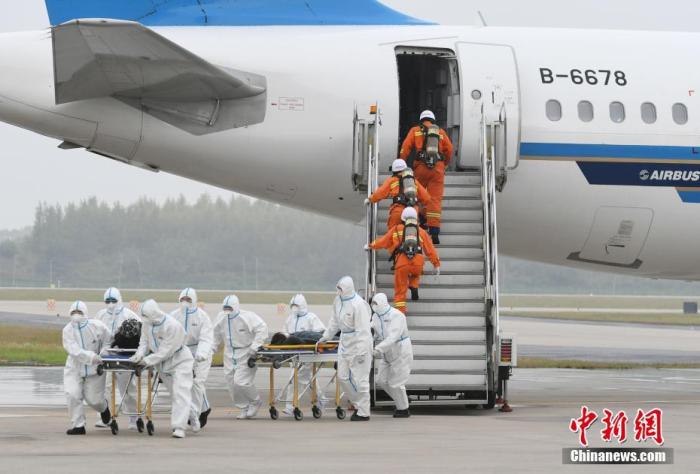Chinanews.com, October 3rd. On October 2, the National Health Commission released the "Law of the People's Republic of China on the Prevention and Control of Infectious Diseases" (Revised Draft for Solicitation of Comments) (hereinafter referred to as "Opinion Draft") on its official website for public solicitation opinion.
In terms of the main content of the revision, the "Draft Opinions" clearly improved the classification system of infectious diseases, focused on the prevention and control of clustered diseases with unknown causes, improved the reporting system of infectious disease epidemics, and reconstructed the information disclosure system of infectious disease epidemics.
Data map: On September 23, Changchun Longjia International Airport carried out the "Tongxin-2020" emergency rescue comprehensive drill.
Photo by China News Agency reporter Zhang Yao
Regarding the overall revision of the idea, the National Health Commission pointed out: summarize and analyze the shortcomings and weaknesses exposed in the prevention and control of the new crown epidemic, identify key and difficult issues, carry out targeted law revision work, improve the lack of systems, and strengthen the law. Effectiveness and operability.
Focus on improving the public health legal system, pay attention to the coordination and connection between relevant laws, and ensure that the relevant system design is in line with the "Border Health and Quarantine Law", "Animal Epidemic Prevention Law", "Emergency Response Law" and other laws to ensure The systemicity and coordination among relevant laws have continuously strengthened the legal protection of public health.
Regarding the main content of the amendment, the National Health Commission made the following explanation:
(1) Improve the purpose of the legislation, and include the adherence to the overall national security concept and the protection of the lives and health of the people into the law.
Emphasize the adherence to the prevention and control principles of government-led, legal prevention and control, scientific prevention and control, joint prevention and control, and group prevention and group control.
(2) Establish and improve the leadership system and mechanism for the prevention and control of infectious diseases, establish a joint prevention and control mechanism, and further strengthen the responsibilities of the Quartet.
(3) Improve the classification system of infectious diseases.
The characteristics of the three types of infectious diseases of A, B, and C have been clarified, and different types of infectious diseases have been differentiated in terms of monitoring scope, reporting subject, and reporting time limit, further highlighting the key points and reflecting the concept of classified management.
(4) Focus on the prevention and control of cluster diseases of unknown causes.
On the basis of Class A, B, C, and C three notifiable infectious diseases, we will add "clustered diseases of unknown cause with epidemiological characteristics of infectious diseases", and further improve the targeted measures in reporting, management and control.
(5) Improve the surveillance system of infectious disease epidemic situation.
Carry out monitoring through multiple channels, establish a system for mutual communication and sharing of clinical medical and disease control information, and establish a cross-departmental and cross-regional monitoring information sharing mechanism.
(6) Improve the early warning system of infectious disease epidemic situation.
The disease control agencies at all levels issue health risk reminders based on the results of multi-channel infectious disease monitoring information and risk assessments, and provide early warning recommendations to the health authorities at the same level. The health authorities organize the evaluation and make recommendations to the people’s governments at the same level. The people's government above the level decided to issue an early warning and initiate an emergency response.
(7) Improve the reporting system of infectious diseases.
Clarify the reporting responsibilities and time limit requirements of institutions at all levels and types, and establish a reporting reward and liability exemption system.
(8) Reconstruct the system of publicizing infectious disease epidemic information.
The China Centers for Disease Control and Prevention regularly publishes information on the epidemic situation of statutory infectious diseases nationwide, and disease control agencies at or above the county level regularly publish information on the epidemic situation of statutory infectious diseases in their administrative regions.
When infectious diseases break out or spread, the health authorities of local people's governments at or above the county level shall announce the epidemic information in their administrative regions; when infectious diseases have cross-provincial outbreaks or epidemics, the health authorities of the State Council are responsible for publicizing.
(9) Improve prevention and control measures.
Refine the relevant regulations on grading, stratification and diversion of treatment, increase the public security, industry and information, transportation and other departments to cooperate with the disease control department to carry out the responsibilities of circulation, strengthen the role of technical means such as big data, and increase the relevant regulations of zoning and grading precision prevention and control.
(10) Improve the construction of infectious disease treatment network.
Construct a comprehensive treatment system that combines peacetime and wartime, elevate successful practices such as building shelter hospitals to legal requirements, and give play to the role of Chinese medicine in the treatment of infectious diseases.
(11) Strengthen the protection of infectious disease prevention and control system.
Clarify the rules for the payment of expenses related to the treatment of infectious diseases, and establish a system for emergency supplies and capacity reserves.
(12) Increase penalties for related violations, and increase penalties for cases where individuals and units fail to cooperate in implementing infectious disease prevention and control measures.

